Hydropower–FPV Hybridization for Sustainable Energy Generation in Romania
Abstract
1. Introduction
2. Materials and Methods
2.1. Background
- Floating photovoltaic (FPV);
- Offshore wind (fixed and floating).
2.2. Hydropower Energy Generation Assessment
- Hydrological models (rainfall–runoff models such as HEC-HMS or HBV);
- Statistical approaches (time-series analysis, ARIMA-type models);
- Machine learning methods (LSTM, random forest, hybrid AI models).
- Climate scenario projections (precipitation and temperature trends);
- Reservoir operation models for cascade systems;
- Multi-objective optimization frameworks that balance hydropower, irrigation, navigation, and ecological flows.
- Zăvideni: H = 10 m, VNRL = 50 mil.m3;
- Drăgăşani: H = 10 m, VNRL = 76 mil.m3;
- Arcești: H = 10 m, VNRL = 54 mil.m3;
- Frunzaru: H = 13.5 m, VNRL = 96 mil.m3;
- Ipoteşti: H = 12.8 m, VNRL = 110 mil.m3;
- Rusăneşti: H = 13.5 m, VNRL = 74 mil.m3;
- Izbiceni: H = 13.5 m, VNRL = 74 mil.m3.
- Nlags: represents the number of lagged inflow values used as input features;
- APIdecay: decay factor of the antecedent precipitation index;
- Hhidden: number of neurons in the hidden layer;
- αL2: L2 regularization coefficient;
- ηlearning: initial learning rate of the neural network.
- Nash–Sutcliffe Efficiency (NSE)—to quantify the predictive accuracy relative to observed inflows:
- Root Mean Square Error (RMSE)—to evaluate the magnitude of residuals between observed and simulated values:
- Mean Absolute Percentage Error (MAPE)—to measure relative errors in percentage terms for interpretability:
2.3. FPV Energy Generation Assessment

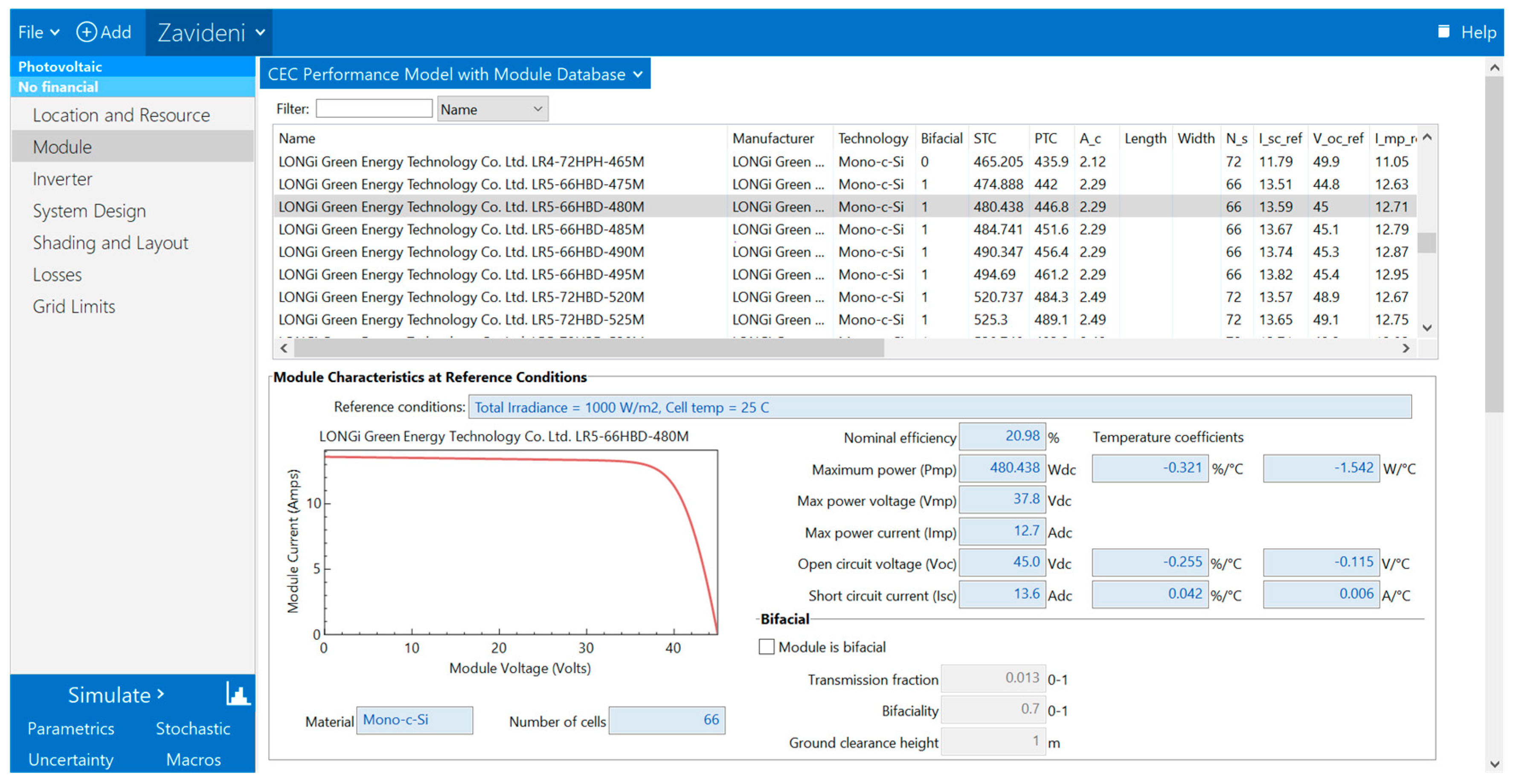
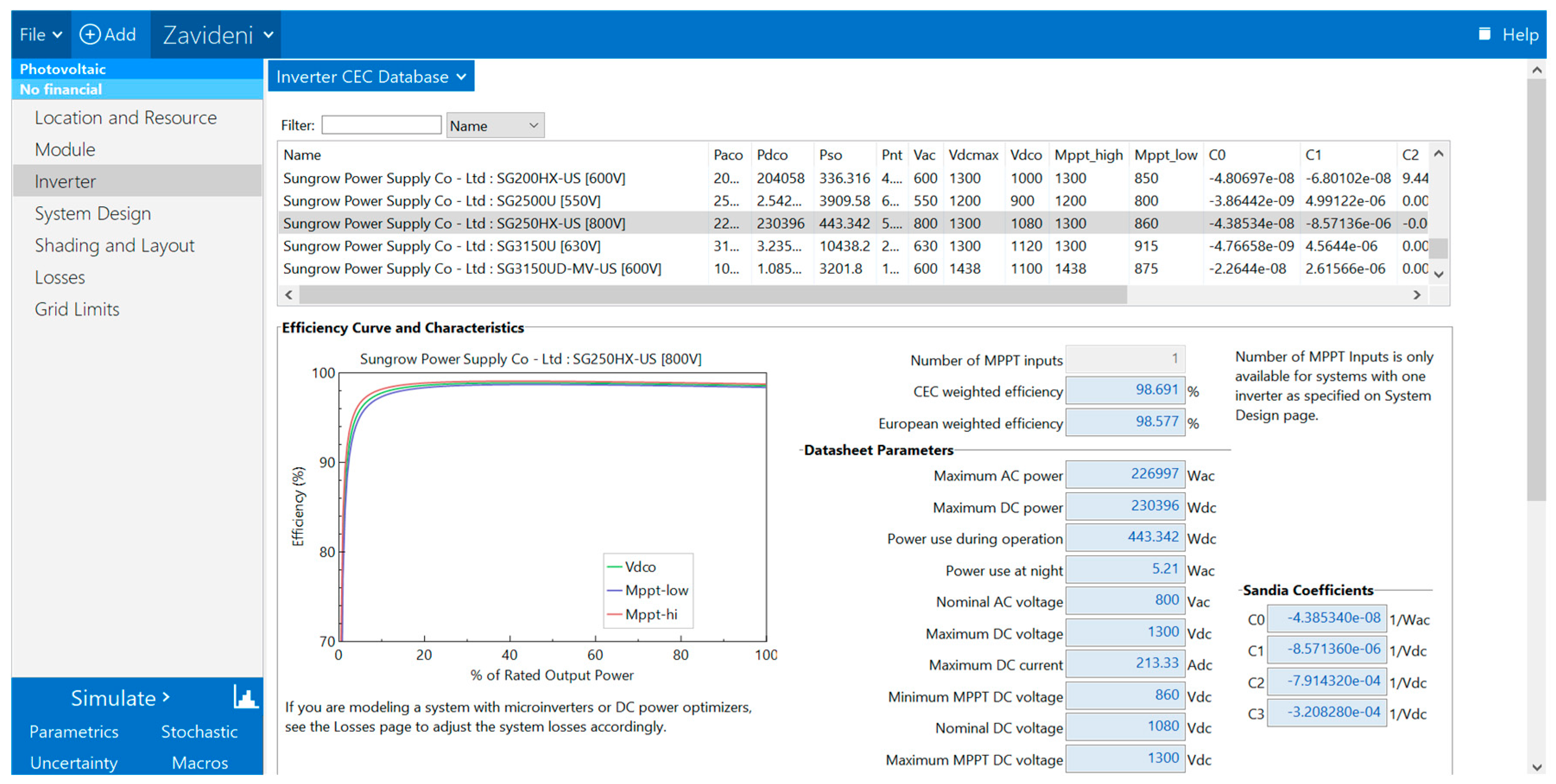
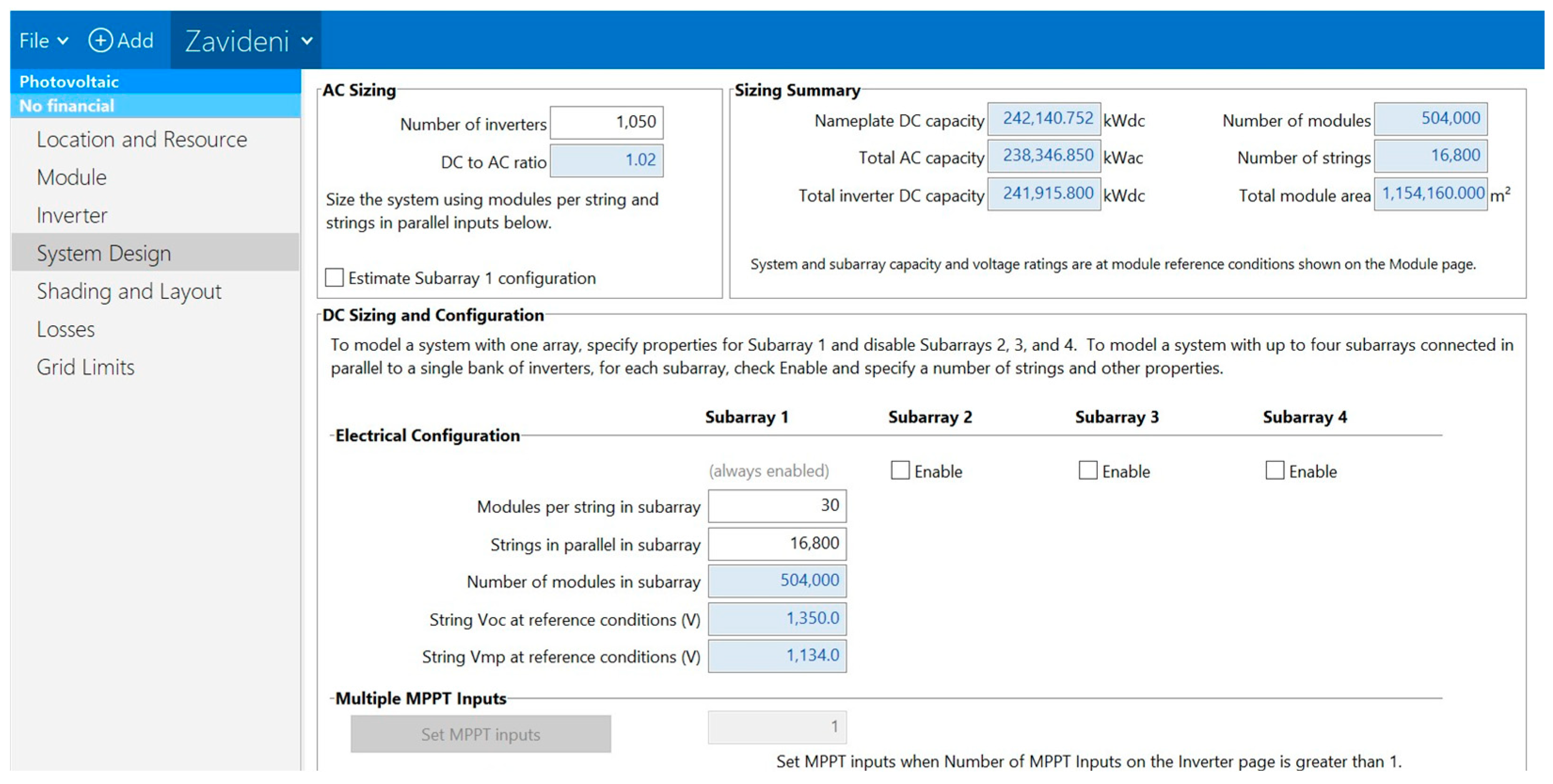
- Tilt angle, set to 10°, according to the technical specifications of floating photovoltaic panels [60];
- Annual losses: a value of 3% was adopted to account for performance reductions caused by environmental factors and equipment degradation;
- Azimuth angle set to 180°.
3. Results and Discussions
3.1. Electricity Generation from Hydropower Plants
- Turbined discharge—the flow used in the HPP for energy generation;
- Withdrawn discharge—the volume extracted from reservoir storage to supplement generation;
- Spilled discharge—the flow released through spillways during high inflow conditions (if applicable).
3.2. Electricity Generation from FPV Plants
- = energy generation with a timestep of 15 min;
- = FPV power in AC (alternative current);
- = FPV power in DC (direct current);
- = inverter efficiency;
- = electrical circuit efficiency;
- = FPV installed capacity;
- = solar radiation [W/m2];
- = thermal coefficient;
- = photovoltaic cell temperature.
3.3. Hydropower-FPV Hybrid Plant Energy Production Trading Strategy
- If ΔP = PDAM − Pstrike > 0, the producer pays the difference ΔP × V (volume) to the buyer;
- If ΔP = PDAM − Pstrike < 0, the buyer pays the difference to the seller.
4. Conclusions
Author Contributions
Funding
Data Availability Statement
Acknowledgments
Conflicts of Interest
References
- United Nations. Transforming Our World: The 2030 Agenda for Sustainable Development. In Proceedings of the United Nations General Assembly, New York, NY, USA, 25 September 2015; A/RES/70/1. Available online: https://sdgs.un.org/2030agenda (accessed on 27 October 2025).
- International Energy Agency (IEA) & United Nations Statistics Division. Tracking SDG 7: The Energy Progress Report 2023; World Bank: Paris, France, 2023; Available online: https://trackingsdg7.esmap.org (accessed on 27 October 2025).
- Quaranta, E.; Rosa-Clot, M. Chapter five—Hydroelectric coupling with floating photovoltaics. In Progress in Floating Photovoltaic Systems; Elsevier: Amsterdam, The Netherlands, 2025; pp. 99–119. [Google Scholar] [CrossRef]
- Kakoulaki, G.; Gonzalez Sanchez, R.; Gracia Amillo, A.; Szabo, S.; De Felice, M.; Farinosi, F.; De Felice, L.; Bisselink, B.; Seliger, R.; Kougias, I.; et al. Benefits of pairing floating solar photovoltaics with hydropower reservoirs in Europe. Renew. Sustain. Energy Rev. 2023, 171, 112989. [Google Scholar] [CrossRef]
- Lee, N.; Grunwald, U.; Rosenlieb, E.; Mirletz, H.; Aznar, A.; Spencer, R.; Cox, S. Hybrid floating solar photovoltaics-hydropower systems: Benefits and global assessment of technical potential. Renew. Energy 2020, 162, 1415–1427. [Google Scholar] [CrossRef]
- Wang, Z.; Wen, X.; Tan, Q.; Fang, G.; Lei, X.; Wang, H.; Yan, J. Potential assessment of large-scale hydro-photovoltaic-wind hybrid systems on a global scale. Renew. Sustain. Energy Rev. 2021, 146, 111154. [Google Scholar] [CrossRef]
- Piancó, F.; Moraes, L.; dos Prazeres, I.; Lima, A.G.G.; Bessa, J.G.; Micheli, L.; Fernández, E.; Almonacid, F. Hydroelectric operation for hybridization with a floating photovoltaic plant: A case study. Renew. Energy 2022, 201, 85–95. [Google Scholar] [CrossRef]
- Lima, A.G.G.; de Mello Junior, H.D.; Quirino, T.M.; Mendoza, L.A.F.; Nunes, G.M.S.; Muller, G.M. Hydro-floating photovoltaic systems as virtual batteries: A case study of Brazil’s Furnas hydropower plant. Renew. Energy 2025, 252, 124036. [Google Scholar] [CrossRef]
- Olkkonen, V.; Haaskjold, K.; Klyve, Ø.S.; Skartlien, R. Techno-economic feasibility of hybrid hydro-FPV systems in Sub-Saharan Africa under different market conditions. Renew. Energy 2023, 215, 118981. [Google Scholar] [CrossRef]
- Micocci, D.; Bragalli, C.; Toth, E.; Wechsler, T.; Zappa, M. Hybridization of an alpine pumped-storage hydropower plant with floating solar photovoltaics: A study from the water resource perspective. Renew. Energy 2025, 253, 123530. [Google Scholar] [CrossRef]
- Fang, W.; Huang, Q.; Huang, S.; Yang, J.; Meng, E.; Li, Y. Optimal sizing of utility-scale photovoltaic power generation complementarily operating with hydropower: A case study of the world’s largest hydro-photovoltaic plant. Energy Convers. Manag. 2017, 136, 161–172. [Google Scholar] [CrossRef]
- Perez, M.; Perez, R.; Ferguson, C.R.; Schlemmer, J. Deploying effectively dispatchable PV on reservoirs: Comparing floating PV to other renewable technologies. Sol. Energy. 2018, 174, 837–847. [Google Scholar] [CrossRef]
- Sahu, A.; Yadav, N.; Sudhakar, K. Floating photovoltaic power plant: A review. Renew. Sustain. Energy Rev. 2016, 66, 815–824. [Google Scholar] [CrossRef]
- Rahaman, M.A.; dos Santos, F.R.; Centenaro, S.H.; Fekih, A.; Wiecheteck, G.; Chambers, T.L. Sustainability assessment of floating photovoltaic (FPV) system: A multidimensional comprehensive analysis across the water-energy nexus. J. Clean. Prod. 2025, 506, 145468. [Google Scholar] [CrossRef]
- Akhtar, Z.; Lalwani, M.; Rao, K.V.S. Estimation of energy potential and evaporation in 20 lakes with FPV in Rajasthan, India. Renew. Energy 2025, 256, 124297. [Google Scholar] [CrossRef]
- Bajc, T.; Kostadinović, D. Potential of usage of the floating photovoltaic systems on natural and artificial lakes in the Republic of Serbia. J. Clean. Prod. 2023, 422, 138598. [Google Scholar] [CrossRef]
- Moraes, C.A.; Valadão, G.F.; Renato, N.S.; Botelho, D.F.; de Oliveira, A.C.L.; Aleman, C.C.; Cunha, F.F. Floating photovoltaic plants as an electricity supply option in the Tocantins–Araguaia basin. Renew. Energy 2022, 193, 264–277. [Google Scholar] [CrossRef]
- Gadzanku, S.; Lee, N.; Dyreson, A. Enabling Floating Solar Photovoltaic (FPV) Deployment. 2022. Available online: https://digitalcommons.mtu.edu/michigantech-p/16825/ (accessed on 30 September 2025).
- Petrollese, M.; Seche, P.; Cocco, D. Analysis and optimization of solar-pumped hydro storage systems integrated in water supply networks. Energy 2019, 189, 116176. [Google Scholar] [CrossRef]
- Casarin, S.; Cavazzini, G.; Pérez-Díaz, J.I. Battery and flywheel hybridization of a reversible pumped-storage hydro power plant for wear and tear reduction. J. Energy Storage 2023, 71, 108059. [Google Scholar] [CrossRef]
- Zhou, Y.; Chang, F.-J.; Chang, L.-C.; Lee, W.-D.; Huang, A.; Xu, C.-Y.; Guo, S. An advanced complementary scheme of floating photovoltaic and hydropower generation flourishing water–food–energy nexus synergies. Appl. Energy 2020, 275, 115389. [Google Scholar] [CrossRef]
- Song, J.; Kim, J.; Chung, W.C.; Jung, D.; Kang, Y.J.; Kim, S. Wave-induced structural response analysis of the supporting frames for multiconnected offshore floating photovoltaic units installed in the inner harbor. Ocean Eng. 2023, 271, 113812. [Google Scholar] [CrossRef]
- Ionescu, C.; Pătrașcu, R.; Sandu, M.R. Integrated operation analysis of a geothermal–solar hybrid system for sustainable thermal energy supply: A case study in the Politehnica Bucharest Campus. UPB Sci. Bull. 2024, 86, 405–416. [Google Scholar]
- Huang, L.; Elzaabalawy, H.; Sarhaan, M.; Sherif, A.; Ding, H.; Ou, B.; Yang, D.; Cerik, B.C. Developing reliable floating solar systems on seas: A review. Ocean Eng. 2025, 322, 120525. [Google Scholar] [CrossRef]
- Dai, J.; Zhang, C.; Lim, H.V.; Ang, K.K.; Qian, X.; Wong, J.L.H.; Tan, S.T.; Wang, C.L. Design and construction of floating modular photovoltaic system for water reservoirs. Energy 2020, 191, 116549. [Google Scholar] [CrossRef]
- Şahin, A.D.; Kara, T.; Mut, A.O.; Korkmaz, M.S.; Kaymak, M.K.; Güloğlu, B. A comprehensive review of economic and policy considerations for floating photovoltaic systems: Insight on national policies and sustainable development goals. Renew. Sustain. Energy Rev. 2025, 223, 116024. [Google Scholar] [CrossRef]
- Hao, R.; Sun, X.; Zhao, Y.; Shang, J.; Zhu, X.; Li, H.; Liu, F. Integrating allocation methods and regional optimization in life cycle assessment of floating photovoltaics for cleaner energy transitions in China. J. Clean. Prod. 2025, 521, 146059. [Google Scholar] [CrossRef]
- Mishra, S.; Harish, V.S.K.V.; Saini, G. Developing design topologies and strategies for the integration of floating solar, hydro, and pumped hydro storage system. Sustain. Cities Soc. 2023, 95, 104609. [Google Scholar] [CrossRef]
- Liu, L.; Sun, Q.; Li, H.; Yin, H.; Ren, X.; Wennersten, R. Evaluating the benefits of integrating floating photovoltaic and pumped storage power system. Energy Convers. Manag. 2019, 194, 173–185. [Google Scholar] [CrossRef]
- Pali, B.S.; Vadhera, S. A novel approach for hydropower generation using photovoltaic electricity as driving energy. Appl. Energy 2021, 302, 117513. [Google Scholar] [CrossRef]
- Wang, G.; Wang, X.; Chen, T. Mapping the potential: A GIS-based approach to assessing floating solar resources for rural electrification in Cambodia. Energy Sustain. Dev. 2025, 87, 101724. [Google Scholar] [CrossRef]
- Kumar, M.; Niyaz, H.M.; Gupta, R. Challenges and opportunities towards the development of floating photovoltaic systems. Sol. Energy Mater. Sol. Cells. 2021, 233, 111408. [Google Scholar] [CrossRef]
- Ramanan, C.J.; Lim, K.H.; Kurnia, J.C.; Roy, S.; Bora, B.J.; Medhi, B.J. Towards sustainable power generation: Recent advancements in floating photovoltaic technologies. Renew. Sustain. Energy Rev. 2024, 194, 114322. [Google Scholar] [CrossRef]
- Garrod, A.; Hussain, S.N.; Ghosh, A.; Nahata, S.; Wynne, C.; Paver, S. An assessment of floating photovoltaic systems and energy storage methods: A comprehensive review. Results Eng. 2024, 194, 114322. [Google Scholar] [CrossRef]
- Manolache, A.I.; Andrei, G.; Rusu, L. An evaluation of the efficiency of the floating solar panels in the western Black Sea and the Razim–Sinoe lagunar system. J. Mar. Sci. Eng. 2023, 11, 203. [Google Scholar] [CrossRef]
- Popa, B.; Vuță, L.I.; Dumitran, G.E.; Picioroagă, I.; Călin-Arhip, M.; Porumb, R.-F. FPV for sustainable electricity generation in a large European city. Sustainability 2022, 14, 349. [Google Scholar] [CrossRef]
- Hidroelectrica (Bucharest, Romania). Annual Report 2023 of the Electricity Production Company in Hydropower Plants. 2024. Available online: https://www.hydro.com.au/about-us/our-governance/annual-report (accessed on 28 May 2025).
- SMHI Hypeweb. Available online: https://hypeweb.smhi.se/explore-water/historical-data/europe-time-series/ (accessed on 10 March 2025).
- Open-Meteo. Available online: https://open-meteo.com/en/docs/historical-weather-api (accessed on 10 March 2025).
- Power plant profile: Rusanesti, Romania. Available online: https://www.power-technology.com/data-insights/power-plant-profile-rusanesti-romania/ (accessed on 20 May 2025).
- Power plant profile: Izbiceni, Romania. Available online: https://www.power-technology.com/data-insights/power-plant-profile-izbiceni-romania/ (accessed on 20 May 2025).
- Power plant profile: Frunzaru, Romania. Available online: https://www.power-technology.com/data-insights/power-plant-profile-frunzaru-romania/ (accessed on 20 May 2025).
- Power plant profile: Ipotesti, Romania. Available online: https://www.power-technology.com/data-insights/power-plant-profile-ipotesti-romania/ (accessed on 20 May 2025).
- România Geografică. Available online: https://romaniadategeografice.net/hidrografie/lacuri/lacuri-z/ (accessed on 20 May 2025).
- Saab, S.M.; Othman, F.; Tan, C.G.; Allawi, M.F.; Sherif, M.; El-Shafie, A. Utilizing deep learning machine for inflow forecasting in two different environment regions: A case study of a tropical and semi-arid region. Environ. Sci. Pollut. Res. 2022, 12, 272. [Google Scholar] [CrossRef]
- Farahani, E.V.; Massah Bavani, A.R.; Roozbahani, A. Enhancing reservoir inflow forecasting precision through Bayesian Neural Network modeling and atmospheric teleconnection pattern analysis. Stoch. Environ. Res. Risk Assess. 2024, 39, 205–229. [Google Scholar] [CrossRef]
- Shoaib, M.; Shamseldin, A.Y.; Melville, B.W. Comparative study of different wavelet based neural network models for rainfall–runoff modeling. J. Hydrol. 2014, 515, 47–58. [Google Scholar] [CrossRef]
- Elmousaid, R.; Adnani, Y.; El Hamdaouy, A.; Elgouri, R. Daily Solar Radiation Prediction Using NARX and MLP-NNs Networks: A Case Study of Kenitra City Morocco; IEEE Xplore: New York, NY, USA, 2022. [Google Scholar] [CrossRef]
- Mohammed, S.J.; Zubaidi, S.L.; Al-Ansari, N.; Ridha, H.M.; Dulaimi, A.; Al-Khafaji, R. Application of Metaheuristic Algorithms and ANN Model for Univariate Water Level Forecasting. Adv. Civ. Eng. 2023, 9947603. [Google Scholar] [CrossRef]
- Chen, J.-F.; Hsieh, H.-N.; Do, Q.H. Forecasting Hoabinh Reservoir’s Incoming Flow: An Application of Neural Networks with the Cuckoo Search Algorithm. Information 2014, 5, 570–586. [Google Scholar] [CrossRef]
- Che Wan Zanial, W.N.; Abdul Malek, M.B.; Md Reba, M.N.; Zaini, N.; Ahmed, A.N.; Sherif, M.; Elshafie, A. River flow prediction based on improved machine learning method: Cuckoo Search–Artificial Neural Network. Appl. Water Sci. 2022, 13, 28. [Google Scholar] [CrossRef]
- Tong, Y.; Yu, B. Research on hyper-parameter optimization of activity recognition algorithm based on improved Cuckoo Search. Entropy 2022, 24, 845. [Google Scholar] [CrossRef]
- Nguyen, A.D.; Nguyen, P.L.; Vu, V.H.; Pham, Q.V.; Nguyen, V.H.; Nguyen, M.H.; Nguyen, T.H.; Nguyen, K. Accurate discharge and water level forecasting using ensemble learning with genetic algorithm and singular spectrum analysis-based denoising. Sci. Rep. 2022, 12, 19870. [Google Scholar] [CrossRef]
- Sheikh, M.R.; Coulibaly, P. Review of recent developments in hydrologic forecast merging techniques. Water 2024, 16, 301. [Google Scholar] [CrossRef]
- Chen, W.; Nguyen, K.A.; Lin, B.-S. Rethinking evaluation metrics in hydrological deep learning: Insights from torrent flow velocity prediction. Sustainability 2025, 17, 8658. [Google Scholar] [CrossRef]
- Lin, Y.; Wang, D.; Jiang, T.; Kang, A. Assessing objective functions in streamflow prediction model training based on the naïve method. Water 2024, 16, 777. [Google Scholar] [CrossRef]
- Moriasi, D.N.; Gitau, M.W.; Pai, N.; Dagupati, P. Hydrologic and water quality models: Performance measures and evaluation criteria. Trans. ASABE 2015, 58, 1763–1785. [Google Scholar] [CrossRef]
- SAM—System Advisor Model. Available online: https://sam.nrel.gov/download.html (accessed on 15 June 2025).
- Venturini, P.; Gagliardi, G.G.; Agati, G.; Cedola, L.; Migliarese Caputi, M.V.; Borello, D. Integration of Floating Photovoltaic Panels with an Italian Hydroelectric Power Plant. Energies 2024, 17, 851. [Google Scholar] [CrossRef]
- Global Solar Atlas. Available online: https://globalsolaratlas.info/map?c=43.824372,24.662247,11&s=43.824549,24.66171&m=site (accessed on 25 June 2025).
- Google Earth. Available online: https://earth.google.com/web/ (accessed on 25 June 2025).
- Curtea de Conturi a României. Available online: https://www.curteadeconturi.ro/ce-facem/raport-public-anual (accessed on 2 September 2025).
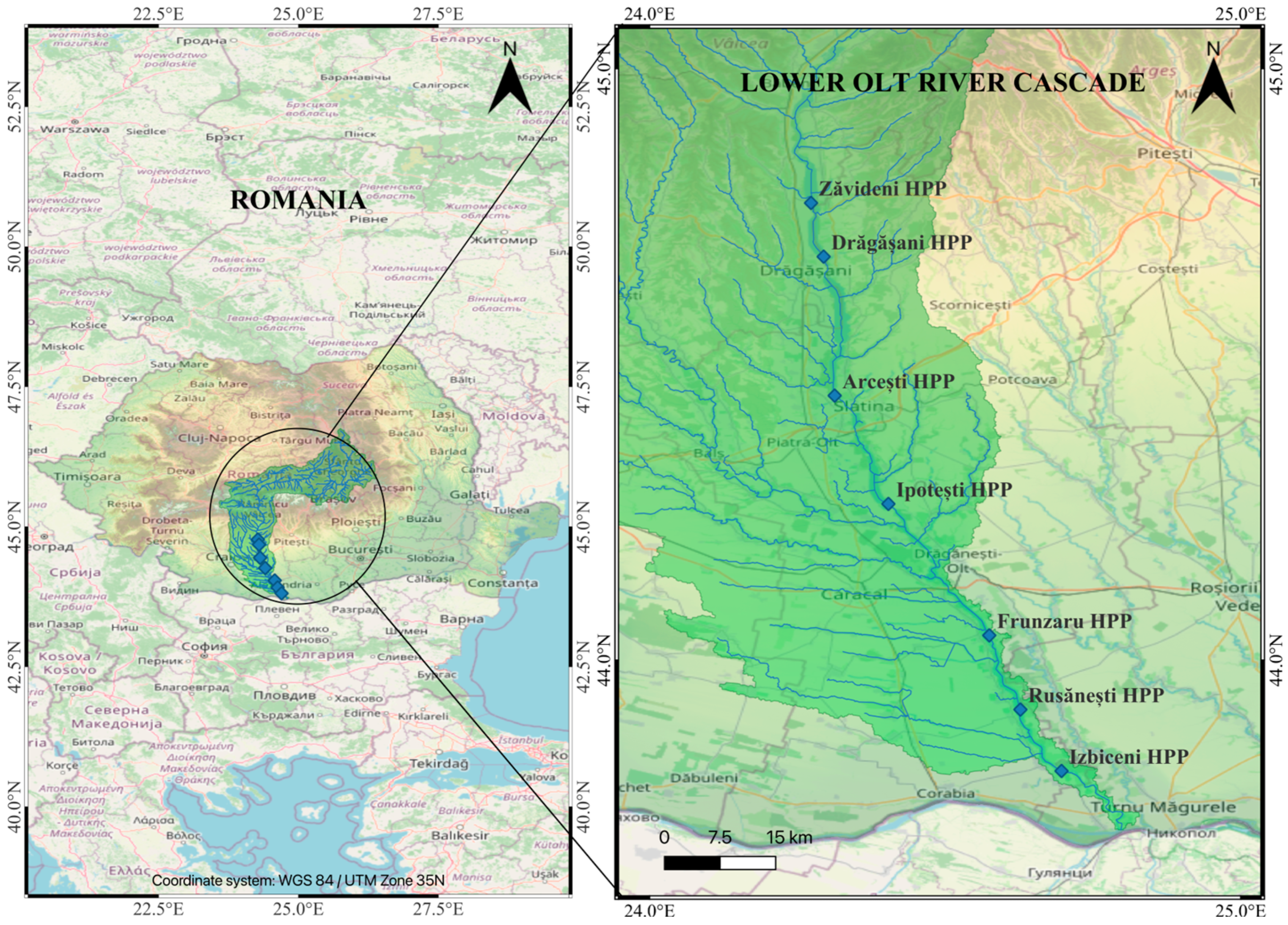
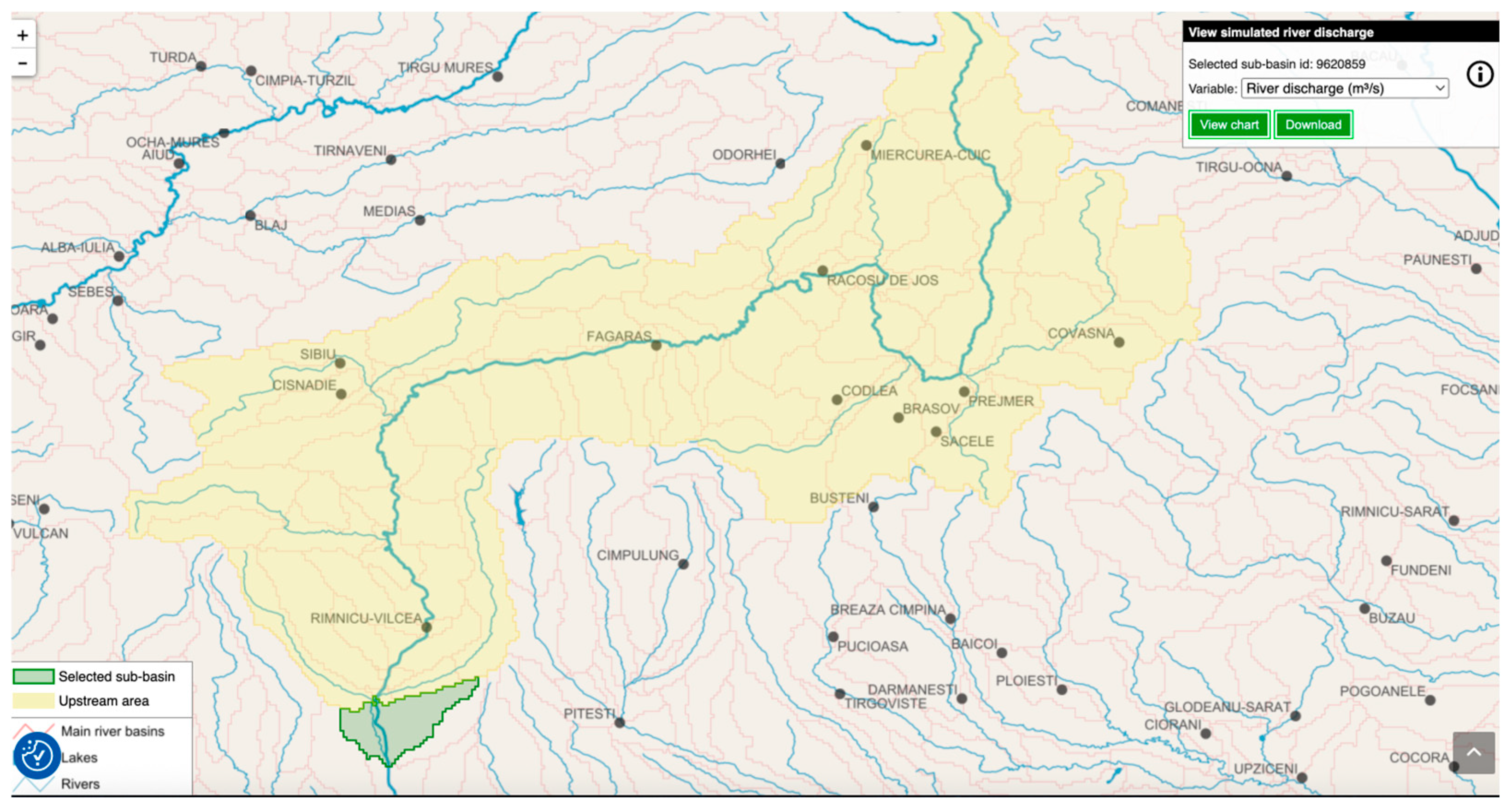

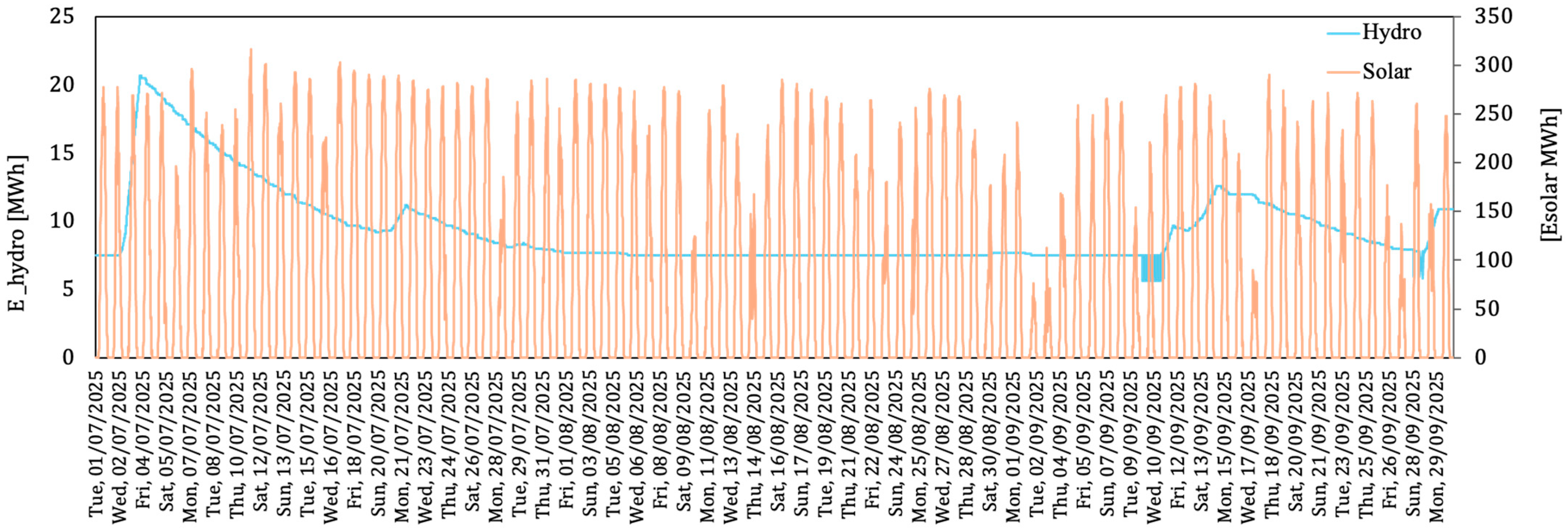

| Reservoir | Average Turbined Discharge (m3/s) | Average Discharge Withdrawn from Reservoir (m3/s) | Average Spilled Discharge (m3/s) |
|---|---|---|---|
| Zăvideni | 70.84 | 0 | 0 |
| Drăgășani | 63.76 | 0 | 0 |
| Arcești | 61.09 | 3.71 | 0 |
| Ipotești | 55.08 | 0.1 | 0 |
| Frunzaru | 49.58 | 0.01 | 0 |
| Rusănești | 44.63 | 0.01 | 0 |
| Izbiceni | 36.14 | 0.44 | 0 |
| Month | July | August | September |
|---|---|---|---|
| Energy | 44.91 | 41.57 | 74.15 |
| Reservoir | Qi (m3/s) | Pi (MW) | Ean (GWh) | Imposed Energy Production (GWh) | ||
|---|---|---|---|---|---|---|
| July | August | September | ||||
| Zăvideni | 330 | 38 | 120 | 8.4 | 8.4 | 9 |
| Drăgășani | 330 | 45 | 140 | 9.8 | 9.8 | 10.5 |
| Arcești | 330 | 38 | 122 | 8.54 | 8.54 | 9.15 |
| Ipotești | 500 | 53 | 98 | 6.86 | 6.86 | 7.35 |
| Frunzaru | 500 | 53 | 104 | 7.28 | 7.28 | 7.8 |
| Rusănești | 500 | 53 | 103 | 7.21 | 7.21 | 7.73 |
| Izbiceni | 500 | 53 | 103 | 7.07 | 7.07 | 7.58 |
| TOTAL | - | - | - | 55.16 | 55.16 | 59.1 |
| Reservoir | Reservoir Area (ha) | FPV Panels Area (ha) | FPV Coverage (%) | FPV Power (MW) |
|---|---|---|---|---|
| Zăvideni | 840 | 115 | 13.69 | 242 |
| Drăgășani | 900 | 102 | 11.33 | 225 |
| Arcești | 800 | 107 | 13.38 | 225 |
| Ipotești | 1400 | 97 | 6.93 | 204 |
| Frunzaru | 970 | 89 | 9.18 | 187 |
| Rusănești | 1100 | 74 | 6.73 | 162 |
| Izbiceni | 880 | 119 | 13.52 | 255 |
| TOTAL | 6890 | 703 | Mean = 10.68 | 1500 |
| Reservoir | FPV Capacity (MWp) | Annual Production SAM (GWh) | Annual Production GSA (GWh) | SAM/GSA (%) |
|---|---|---|---|---|
| Zăvideni | 242 | 310.7 | 272.3 | 12.31 |
| Drăgășani | 225 | 290.8 | 254.1 | 12.45 |
| Arcești | 225 | 298.0 | 256.0 | 14.96 |
| Ipotești | 204 | 256.9 | 233.8 | 14.34 |
| Frunzaru | 187 | 253.3 | 206.6 | 18.33 |
| Rușănești | 162 | 217.0 | 185.5 | 14.35 |
| Izbiceni | 255 | 348.4 | 258.8 | 15.75 |
| TOTAL | 1500 | 1975.5 | 1667.1 | - |
| Power Plant | July | August | September |
|---|---|---|---|
| HPP—scenario 1 | 44.91 | 41.57 | 74.15 |
| HPP—scenario 2 | 55.16 | 55.16 | 59.10 |
| FPV | 265.00 | 223.70 | 172.40 |
| TOTAL—scenario 1 | 309.91 | 265.27 | 246.55 |
| TOTAL—scenario 2 | 320.16 | 278.86 | 231.50 |
| Revenue Collected (mil. RON) | July | August | September | Total |
|---|---|---|---|---|
| HPP—scenario 1 | 34.58 | 32.01 | 57.10 | 123.69 |
| HPP—scenario 2 | 42.47 | 42.47 | 45.51 | 130.45 |
| Type of Contract | July | August | September | Total 3 Months |
|---|---|---|---|---|
| PBC hydro | 1,265,970 | 1,149,479 | 1,942,557 | 4,358,006 |
| VPPA FPV | 9,345,596 | 5,725,923 | 5,725,923 | 20,797,442 |
| TOTAL | 10,611,566 | 6,875,402 | 7,668,480 | 25,155,448 |
Disclaimer/Publisher’s Note: The statements, opinions and data contained in all publications are solely those of the individual author(s) and contributor(s) and not of MDPI and/or the editor(s). MDPI and/or the editor(s) disclaim responsibility for any injury to people or property resulting from any ideas, methods, instructions or products referred to in the content. |
© 2025 by the authors. Licensee MDPI, Basel, Switzerland. This article is an open access article distributed under the terms and conditions of the Creative Commons Attribution (CC BY) license (https://creativecommons.org/licenses/by/4.0/).
Share and Cite
Bratu, O.-I.; Tică, E.-I.; Neagoe, A.; Popa, B. Hydropower–FPV Hybridization for Sustainable Energy Generation in Romania. Water 2025, 17, 3144. https://doi.org/10.3390/w17213144
Bratu O-I, Tică E-I, Neagoe A, Popa B. Hydropower–FPV Hybridization for Sustainable Energy Generation in Romania. Water. 2025; 17(21):3144. https://doi.org/10.3390/w17213144
Chicago/Turabian StyleBratu, Octavia-Iuliana, Eliza-Isabela Tică, Angela Neagoe, and Bogdan Popa. 2025. "Hydropower–FPV Hybridization for Sustainable Energy Generation in Romania" Water 17, no. 21: 3144. https://doi.org/10.3390/w17213144
APA StyleBratu, O.-I., Tică, E.-I., Neagoe, A., & Popa, B. (2025). Hydropower–FPV Hybridization for Sustainable Energy Generation in Romania. Water, 17(21), 3144. https://doi.org/10.3390/w17213144









